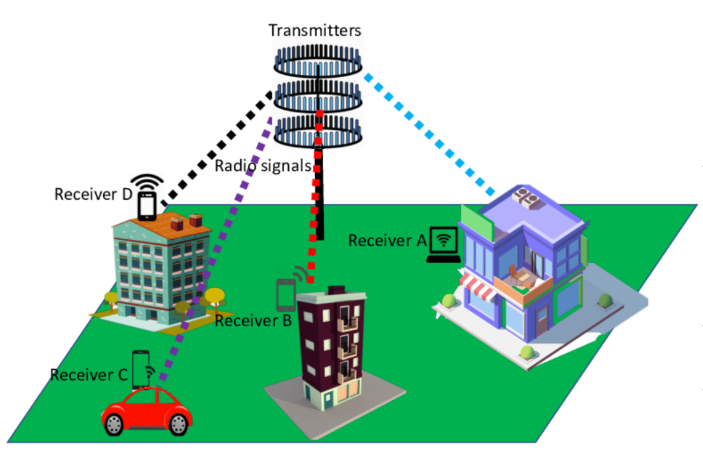The Role of MIMO (Multiple‐Input, Multiple‐Output) Technology in Enhancing 5G Network Performance
 Stephen Oke
Stephen OkeWhat is MIMO?
MIMO is a wireless technology that uses multiple antennas at the source (the transmitter) and the destination (the receiver). The antennas at each end of the communications circuit are combined to reduce errors, improve data speed, and increase the capacity of radio transmissions.
MIMO divides a single data stream into multiple streams, modulated and transmitted through separate radio-antenna chains on the same frequency channel. This technique improves radio transmission performance using environmental structures and multipath signal reflections.
Multiple versions of the same signal are produced to improve the signal-to-noise ratio. This gives the data more chances to reach the receiving antenna, unaffected by fading. MIMO reduces congestion and improves connection stability by increasing the capacity of radio frequency (RF) systems.
Multiple-Input: Refers to multiple antennas at the transmitter (a base station or a wireless router). These antennae can transmit several data streams at once.
Multiple-Output: Refers to multiple antennas at the receiver (e.g., a smartphone or a computer). These antennas can receive and process various data streams together.

Figure 1. Pictorial representation of MIMO.
History and Evolution of MIMO
The history and development of MIMO technology in wireless networks span several decades. MIMO research began in the 1970s, with a large part of it focused on multi-channel systems and interference. The 1970s research laid the groundwork for the 1980s theory of cross-coupled networks, which was essential for developing the first MIMO systems.
Basic beam switching and signal propagation were accessible by the 1990s, but processing power constraints prevented further development. In the early 1990s, as processing power increased, work on MIMO systems began. The primary goal of these studies was to reduce signal degradation by using MIMO systems in multi-path transmission.
As processing power improved, MIMO systems were modified to take advantage of additional signal paths to carry more data while improving signal quality.
Arogyaswami Paulraj and Thomas Kailath were the ones who first proposed spatial multiplexing, and they were granted a patent for the technology in 1994. However, Bell Labs was the one who used V-BLAST in 1998 to introduce the technology to the public.
How is MIMO Integrated Into the 5G Network?
MIMO plays an important role in determining the trend as the world moves towards 5G development. 5G networks use Massive MIMO, an advanced MIMO configuration that uses multiple antennas to serve multiple users.
For applications like augmented reality and the Internet of Things (IoT), this leads to fast data speeds and low-latency communications.
How MIMO Technology Improves Data in 5G Network
The increasing variety of mobile applications has created a need for gigabit data rates to serve users in high and low-mobility situations. MIMO antennas are replacing the traditional single antennas found in mobile devices to meet this requirement.
Mobile devices can provide improved quality of service, high data rates, uninterrupted signals, and enhanced spectral efficiency by using MIMO technology.
Some of the benefits of MIMO are listed below:
Higher data rates: With MIMO technology, multiple data streams can be transmitted over the same frequency band, allowing for higher data rates than with traditional single-input, single-output systems.
Enhanced signal quality: By lessening the effects of noise, interference, and fading, MIMO technology helps to enhance signal quality.
Enhanced coverage and range: By improving link quality and lowering the possibility of signal dropouts, MIMO technology can increase the coverage and range of wireless networks. A larger MIMO array or massive MIMO can produce a more directed beam, increasing coverage area compared to a traditional SISO system.
Improved spectral efficiency: MIMO technology makes it possible to use the radio spectrum available more efficiently by improving spectral efficiency. Multiple data streams are sent or received together to accomplish this.
Compatibility with current standards: MIMO technology can be easily combined with the current wireless networks without requiring notable changes because it is compatible with current wireless standards.
What are the Limitations of MIMO Technology?
MIMO technology offers numerous benefits for wireless communication. However, its application can be limited by several challenges.
Some of the notable challenges are:
Mobility challenges: MIMO systems may face challenges in highly mobile environments, like data transmitted between vehicles. Sudden changes in channel conditions may affect MIMO's ability to use spatial diversity effectively.
Spatial multiplexing limitations: One important aspect of MIMO is spatial multiplexing, which enables the transmission of multiple data streams. Nevertheless, it can be weakened when there is a high channel interaction or no line of sight.
Hardware complexity and cost: Using multiple antennas and radio chains in MIMO implementation increases the complexity and cost of hardware. The stationing cost of MIMO systems may increase due to the requirement for extra hardware, such as multiple antennas and RF chains.
Interference and crosstalk: When there are a lot of devices around, MIMO systems are exposed to interference and crosstalk between multiple antennas.
Regulatory restrictions: In some regions, laws controlling specific frequency bands or power levels may make it more difficult to implement MIMO technology.
Energy consumption: MIMO systems use more energy due to increased complexity and computational demands, especially in battery-powered devices.
What is the Future of MIMO?
Massive MIMO builds on the traditional MIMO technique, which uses multiple antennas at the transmitter and receiver to enhance communication efficiency. However, Massive MIMO goes one step further by using a notably higher quantity of antennas at the base station to achieve data rates and reliability.
Furthermore, several trends and advanced features of massive MIMO have surfaced in recent years, and these are expected to change the design of 6G wireless networks and systems in the future.
Massive MIMO will also lead to the emergence and success of a wider range of vertical applications, including remote sensing, vehicular communications, non-terrestrial communications, wireless localisation and sensing, and interplanetary communications.
Reference
Subscribe to my newsletter
Read articles from Stephen Oke directly inside your inbox. Subscribe to the newsletter, and don't miss out.
Written by
